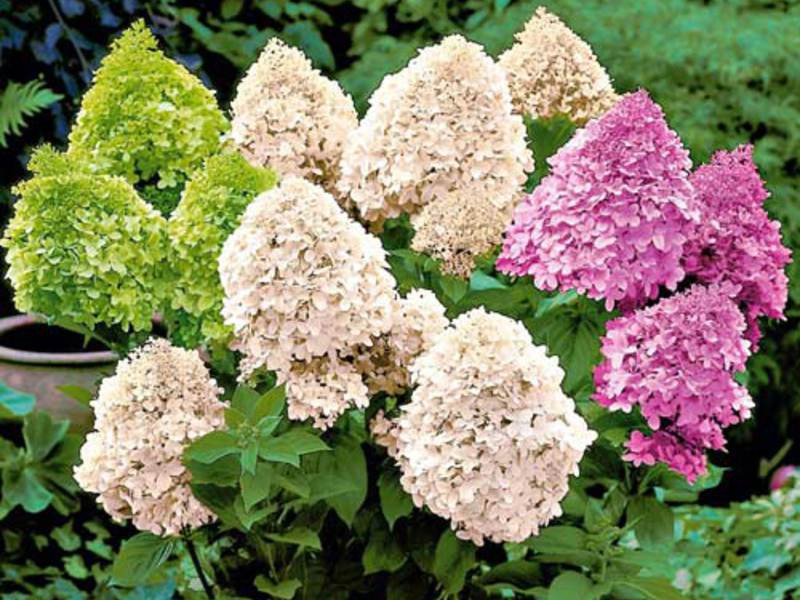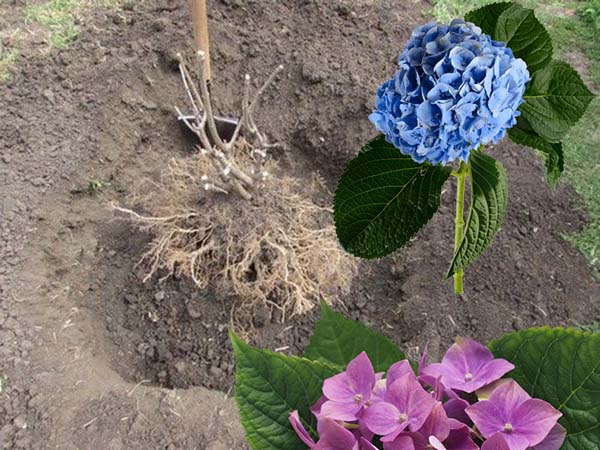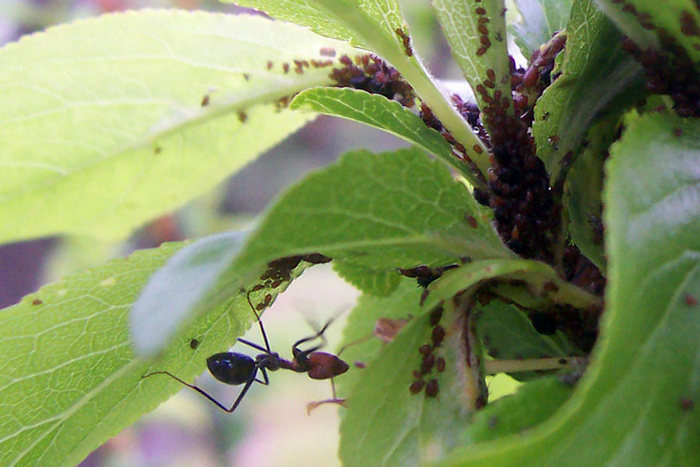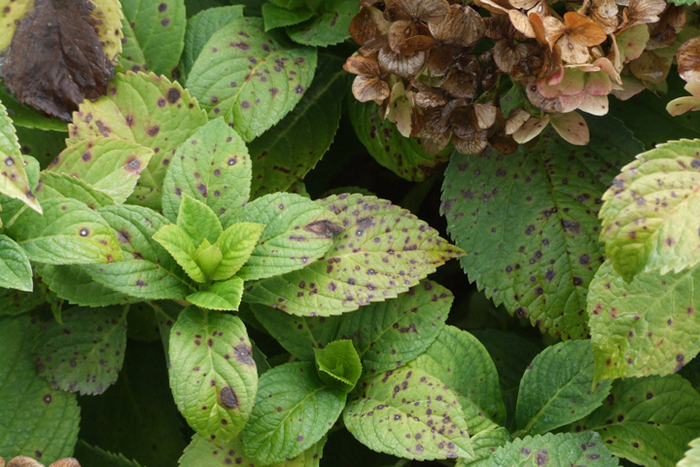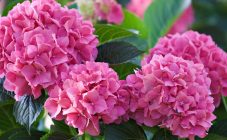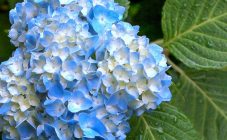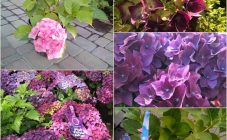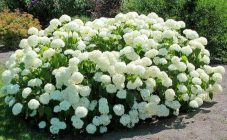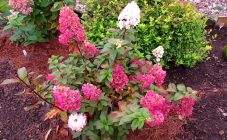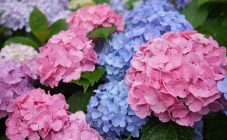Content:
Gardeners are happy to beautify their plots. Flower arrangements, alpine slides and artificial reservoirs with ornamental plants are visible next to the vegetable beds. Gardeners choose hydrangea as one of the central plantings of the flower ensemble. Especially the panicle type, since it is the most frost-resistant and suitable for many climatic zones.
Description
Hydrangea paniculata belongs to the genus Hortensia. There are shrub and tree species. At home (China, Japan, South Sakhalin), hydrangea grows up to ten meters in height. Therefore, calling a culture a flower can be very conditional. In early summer, wide-pyramidal long (about 30 cm) panicles are laid on the tops of the stems, which bloom magnificently and remain so from June to October. Only the color changes: at the beginning of the pyramid it is beige-white, then snow-white and then pink. In late autumn, the panicles turn red with green freckles. The flowers of the hydrangea are sterile.
In the conditions of the Moscow region, Central Russia, the Urals and the territory of the Leningrad region, the panicle hydrangea does not need to be covered for the winter. But in Siberia this variety needs winter protection.
The beauty of the plant is given by large (about 12 cm in length) oval leaves. Flowers are of two types in one panicle. The seed flowers are small and rapidly falling, while the sterile ones are somewhat larger. Hydrangea begins to bloom in the fifth season and lasts from June to the end of September.
Agrotechnics of culture
Cultivation conditions:
- landing site - partial shade;
- air temperature up to 25 degrees;
- the composition of the soil is acidic;
- top dressing;
- watering.
The main pruning of the bush is carried out in the spring. In this case, the old stems are cut to three or four living buds. You can organize a rejuvenating pruning on an old bush, that is, cut off old branches onto a stump. And also to form a plant in the form of a tree, for which lateral shoots are cut off and the crown is formed from several skeletal branches.
Autumn pruning should be done when sap flow in plant tissues slows down.
For different regions, the dates may differ:
- In the Moscow region and Central Russia - this is the beginning of November (sometimes the last decade of October), when the first snow falls on the ground.
- In the Urals, in Siberia, it is correct to perform circumcision in mid-October.
- In Siberia, the summer is short and they begin to prepare for wintering at the end of September, just before the shelter.
- In the Leningrad region, the cold comes earlier, and the pre-winter formation of the bush should be carried out until mid-October.
Formative pruning of the crown of hydrangea begins in the third year after planting.
Reproduction of hydrangea
Reproduction of culture is not difficult at all. With a little effort, a beginner can figure it out. Moreover, there are several ways and you can choose the most suitable one.
Cuttings
The method of cultivation by cuttings remains the most popular. Planting material is prepared in early summer. Rather, plants rooted at this time can be planted in the garden in the current season. Later cuttings provide for room maintenance of seedlings until next spring.
Planting material is harvested from healthy, non-lignified lateral branches. The tops are cut off immediately - they are not needed. The remaining segment should be divided into pieces with two to three pairs of leaves. It is very important to carry out cuttings in cloudy weather or early in the morning. The twigs should contain the maximum amount of moisture. For the same reason, the cut branches are immediately placed in the water.
After three days, the cut branches are ready for planting in the ground (in pots). Before planting, it is required to process the lower cut with a root formation stimulator ("Kornevin", "Epin"), and seal the upper one with paraffin. Sometimes honey is used instead of a stimulant.
The soil for planting the material is prepared ahead of time. A mixture of sand and peat (1: 2) is suitable. You can use a ready-made primer, for example, flower.
Each piece is planted to a depth of no more than 3 cm and covered with a jar. For best rooting, the soil must always be moist.
It takes about a month to root. When fresh leaves appear, seedlings can be planted in separate pots and grown at home until spring. Before planting in open ground, the seedlings should be hardened, that is, gradually accustomed to lowering the temperature.
Layers
Another effective method of breeding hydrangeas is the ability of the plant to reproduce by layering. These works are carried out in early spring or before winter.
Gardeners prefer to combine this method with autumn pruning and preparing the bush for winter.
First of all, you need to loosen the root zone of the plant. Then a radial groove should be dug around the bush and one branch should be laid there (pinned in several places). The top of the branch should remain above the ground. With proper planting, the first shoots will appear in half a month. In the future, they need to be hilled and watered. It is not advised to touch the seedlings until next season.
Seed propagation
If desired, hydrangeas can be propagated by seed. But seed germination is very low, and the probability of obtaining the desired variety is not enough. But the lesson itself is quite exciting, so there are also many fans of this method. He was especially fond of breeders.
For sowing, dry, dense seeds are chosen. Sowing outdoors is carried out in early spring. You can also grow seedlings indoors and plant in the garden after two years. The time for this is chosen in February - March.
Seeds can be planted in two ways:
- with germination, that is, the seeds are soaked until the roots appear;
- directly into the ground.
In the second method, the seeds should be soaked in a pink manganese solution or Epine growth stimulator.
The seedbed can be mixed by yourself. A mixture of humus, peat, sand and earth in equal compositions is well suited.
The seeds are not buried in the ground, but only slightly sprinkled with sand. After good moisture, the plantings are covered with a film. In the future, humidity and heat are maintained at 14-20 ° C.
Hydrangea paniculata: planting and care in the open field
For hydrangeas, partial shade or a sunny area is best. In this case, the bush must be protected from cold winds. If we talk about the planting season, then the best time is spring, since the hydrangea will have time to take root well over the summer.
Soil and planting
The flower prefers a slightly acidic soil composition and does not like sand at all.
Planting and transplanting a plant:
- A pit is being prepared, measuring about 40 × 50 × 50 cm, and for large varieties, with powerful roots, 55 × 75 × 75 cm.
- 2-3 buckets of water are poured into each hole.
- The next day, fertilizers are poured onto the bottom of the hole (for spring planting, this is 1 tbsp. L. Urea and potassium sulfate), a mixture of peat, garden soil, humus and sand in equal amounts.
- The contents of the well are thoroughly mixed.
- A seedling is planted in the prepared soil, and the earth around the root is well compacted. The bush should be transplanted from place to place in the same order.
- Plantings are watered at the rate of 30 liters per 1m².
In the future, you should water the bushes abundantly once a week. If the summer is rainy, then watering can be reduced. In any case, the soil under the bush must be constantly moist. To protect the plant from drying out, you can mulch the near-stem zone. Suitable for this purpose:
- peat;
- sawdust;
- humus;
- rotted leaves.
During the growing season, hydrangea is fertilized 4 times.
Top dressing
The first spring feeding is carried out with nitrogen fertilizers (potassium sulfate and urea). Because the plant needs to grow green mass. For one bush, 1 tsp is enough. each fertilizer for half a bucket of water. As fertilizer, liquid manure diluted in water in a ratio of 1:10 is used.
The second feeding is shown during the budding period. At this time, potash and phosphorus supplements will be the best, for example, superphosphate in a ratio of 1 tsp. for 5 liters of water.
The last dressing is applied at the beginning of autumn. These are potassium sulfate and superphosphate. For one bush, a solution of 2 tbsp is enough. l. fertilizer mixture on a bucket of water.
Reasons for the lack of flowers
Sometimes hydrangea does not bloom and the main reasons may be:
- Bad wintering. Flower buds were frozen from frost.
- Incorrect cropping. All flower panicles form at the tops of the past year. They cannot be cut in the spring.
- Fertilization errors. During flowering and late autumn, nitrogen fertilizers cannot be used. Only foliage grows from them. Potassium and phosphorus will contribute to good budding.
- Weak root system. At the same time, the plant does not have enough strength to lay flower buds and full flowering. It is better not to let such a plant bloom at all, that is, to cut off even rare buds, and then the next season you can get a full-fledged bush.
And also lead to the lack of colors:
- lack of moisture;
- heat;
- scorching sun or shade;
- unsuitable soil.
Pests and diseases
The lack of flowering can occur with an invasion of pests or plant diseases. They love hydrangea very much:
- aphid;
- spider mite;
- weevil and others.
Diseases:
- viral mosaic disease;
- fungal infections (for example, black fungus);
- powdery mildew;
- gray rot.
You can fight the misfortune with the help of insecticides such as Fitoverm or Aktellik. Sick areas should be cut and burned.
A good flowering bush also depends on age. Old bushes cannot please with lush flowering. Therefore, it is recommended to renew the plant every 4-5 years.
Combination with other cultures
The planting culture is combined with a large number of plants. Hydrangea looks great against the background of conifers. In addition, the needles help hydrangeas to fight many pests. And also panicle hydrangea looks great in single plantings, in flower arrangements, along the paths.You can plant it against the backdrop of an artificial pond. The flower looks amazing in the vicinity of white and lilac lilacs.
Autumn care and preparation of the bush for winter
After flowering, the hydrangea bush must be prepared for wintering. First of all, dry inflorescences are cut off and damaged and old branches are cut.
In the conditions of Central Russia, there is no need to completely cover the bush. Only the roots need good protection.
How bulk material is used:
- humus;
- peat;
- rotted foliage;
- dry spruce needles.
The required layer thickness is at least 20 cm. In spring, the shelter should be opened gradually. Before hiding, the bush is recommended to be fed and watered well.
Variety selection
When choosing a particular variety, beginners often prefer a spectacular appearance. But not all varieties are universal: what is suitable for southern territories does not always survive in a more severe climate.
As for the panicle hydrangea, it feels great in the conditions of Moscow and the Moscow region all year round. There is no need to cover it for the winter, you just need to mulch it well. The shrub grows up to 2 meters and blooms for four months (July-October). Fragrant inflorescences attract bees - hydrangea is an excellent honey plant.
The Siberian climate is somewhat more severe. Although it is said that you can not cover the bushes, experienced gardeners still advise to protect them for the winter. For this, the branches of the bush are collected in a bunch and tied. A hut of spruce branches, boards, polystyrene is erected above the bush and wrapped in a breathable fabric. After heavy snowfall, you can add snow to the hill.
The panicle hydrangea gives the landscape of the summer residence some airiness. Lush large inflorescences resemble conical inflatable figures. And this beauty lasts for 4 months. With one addition - the shade of the buds changes over time, becoming more beautiful from time to time.
